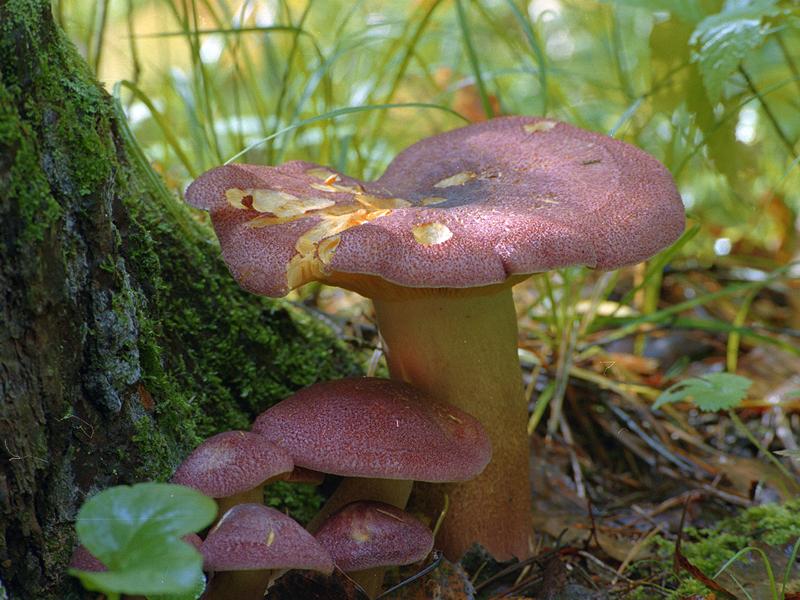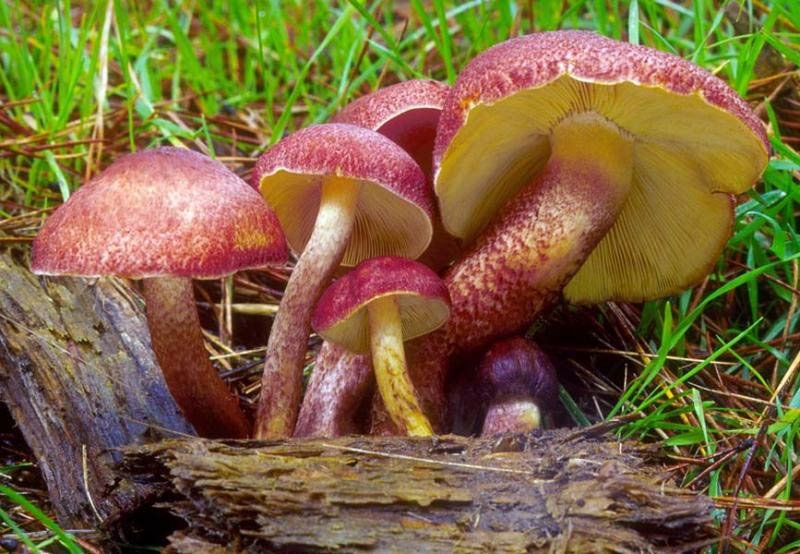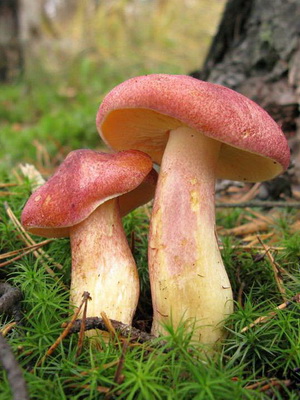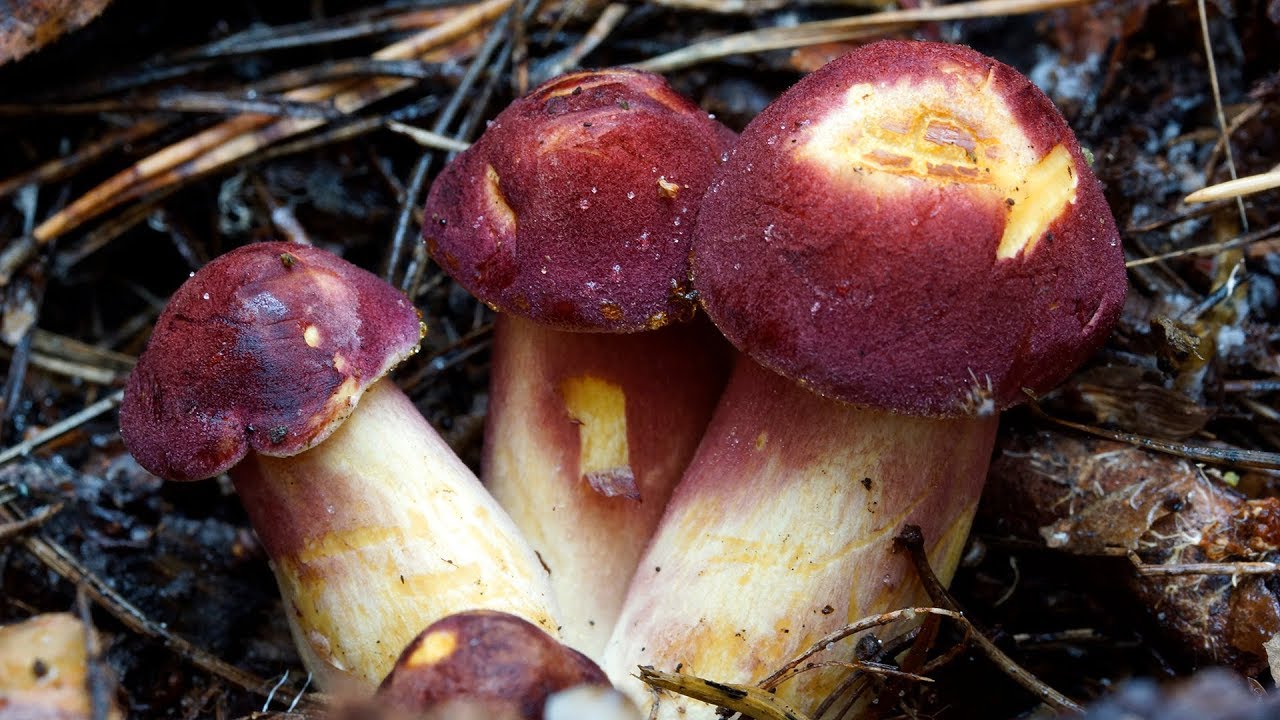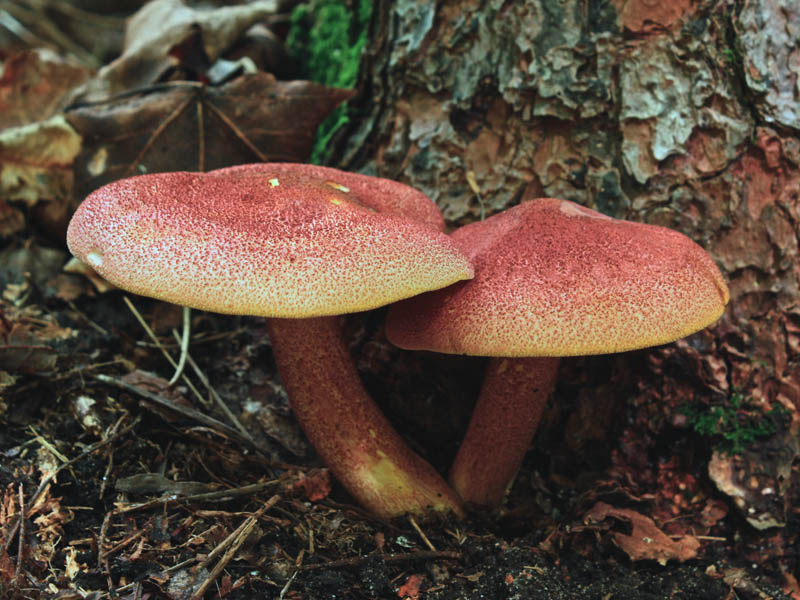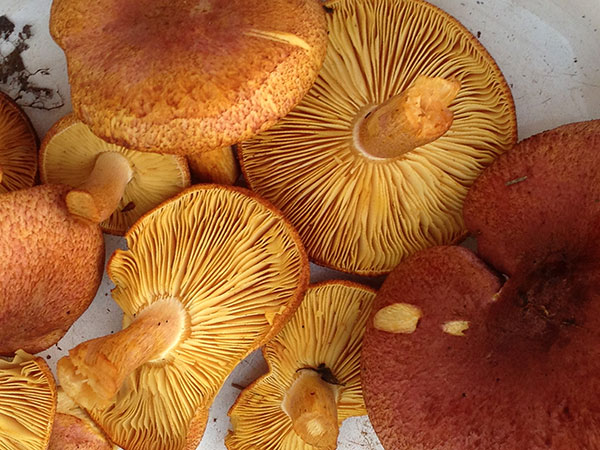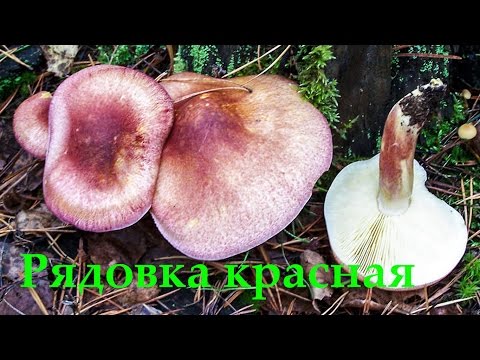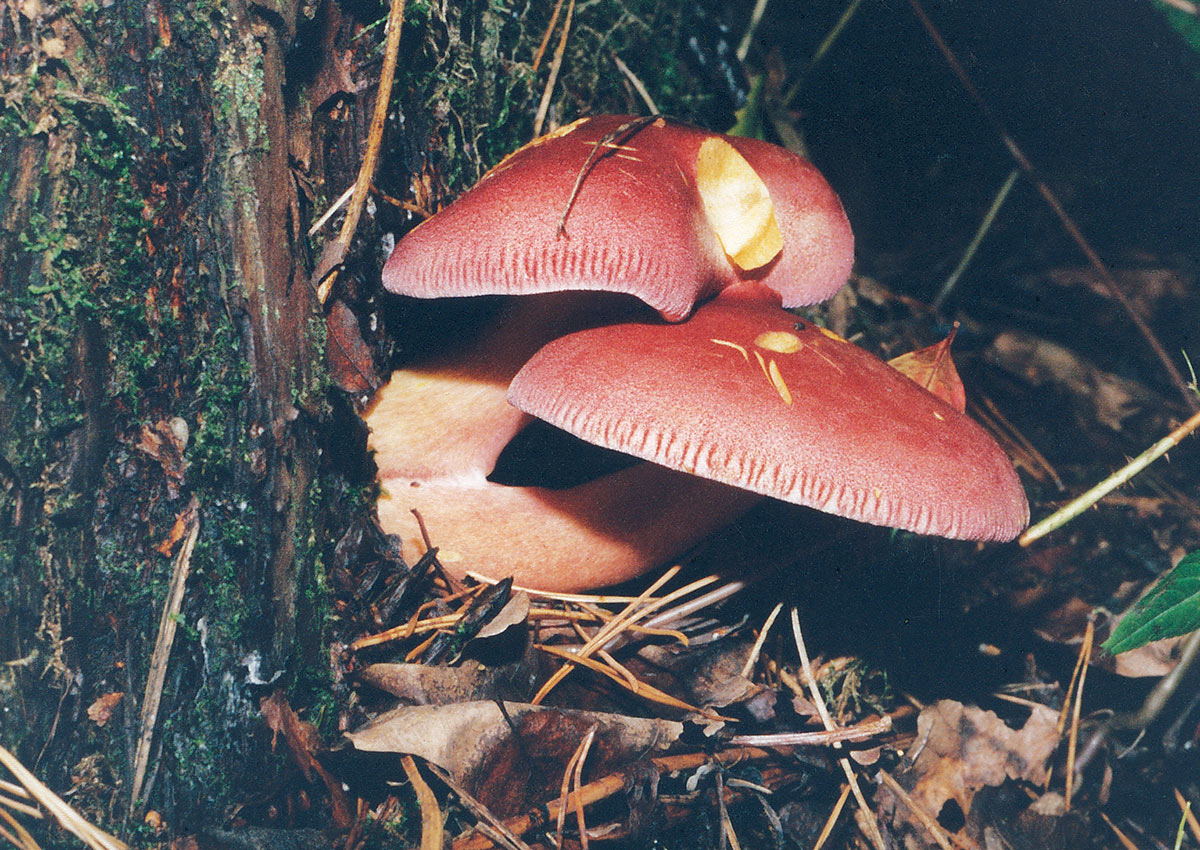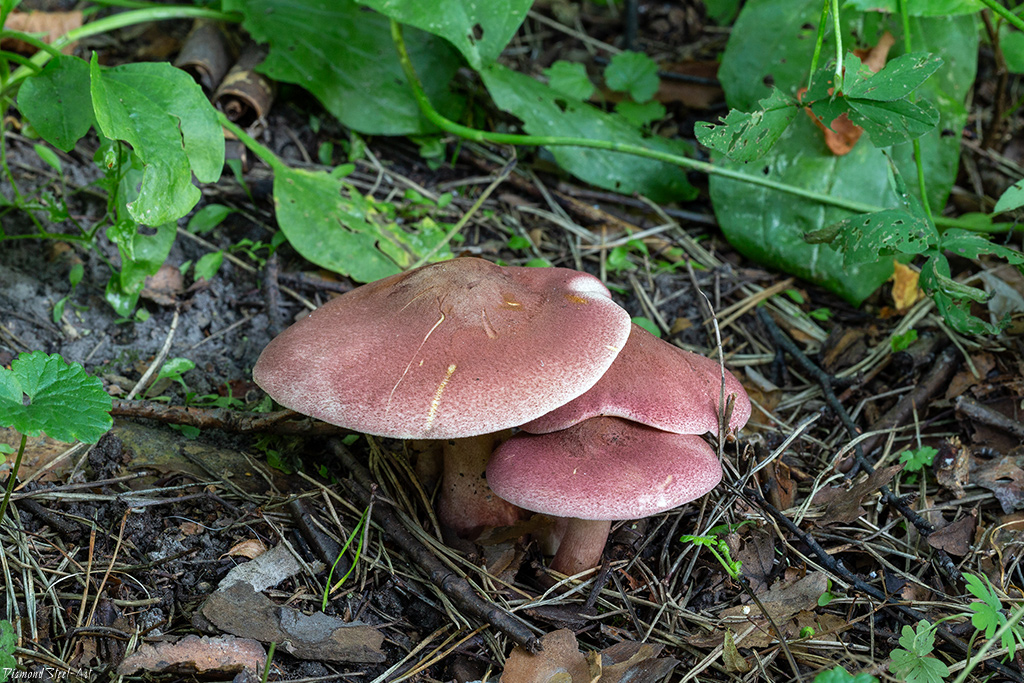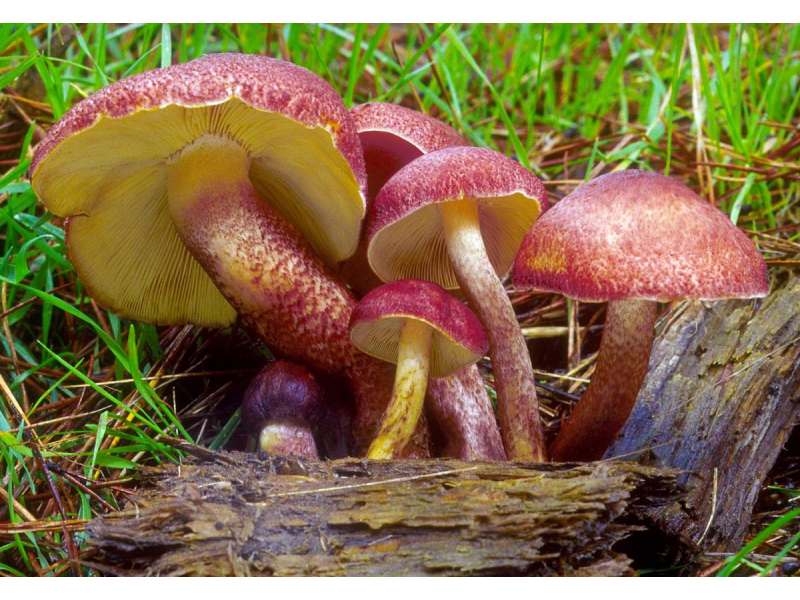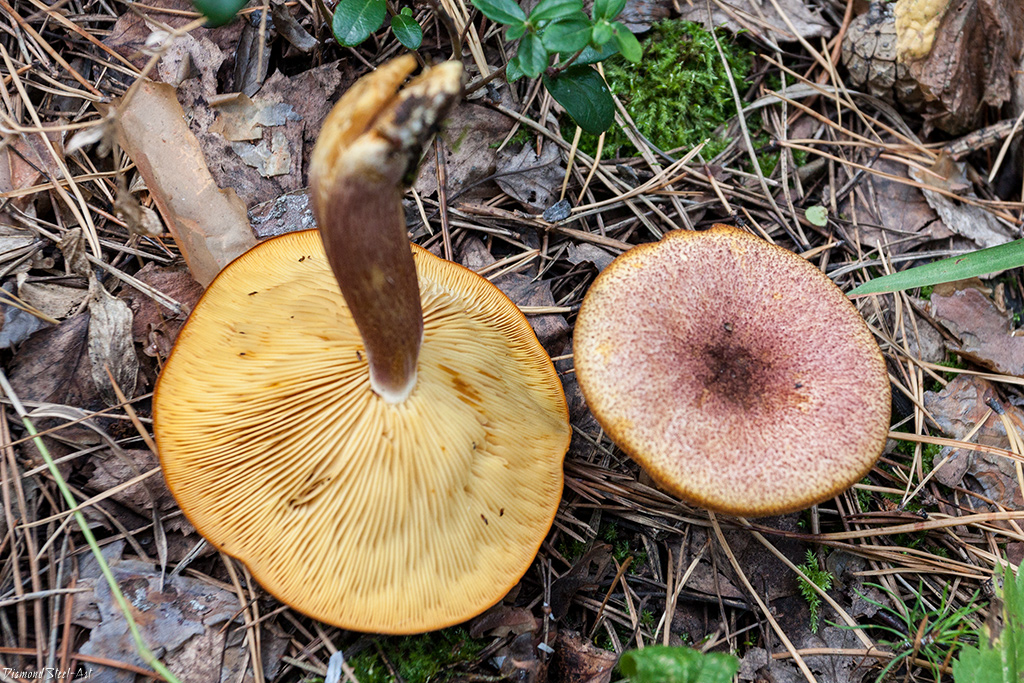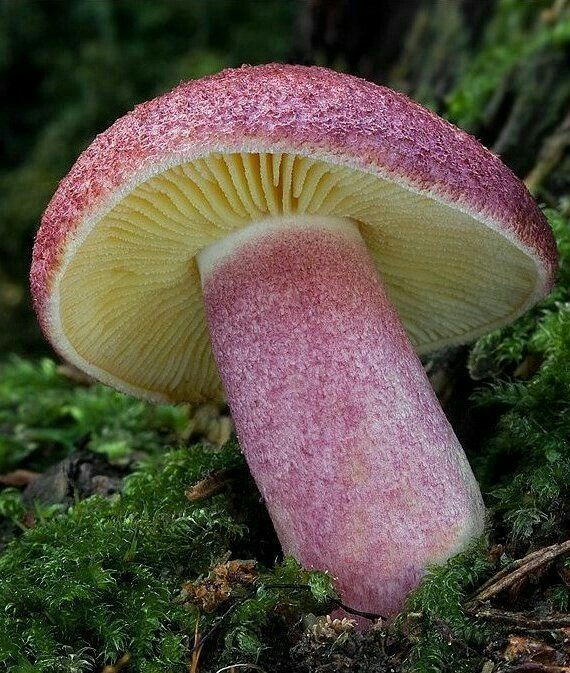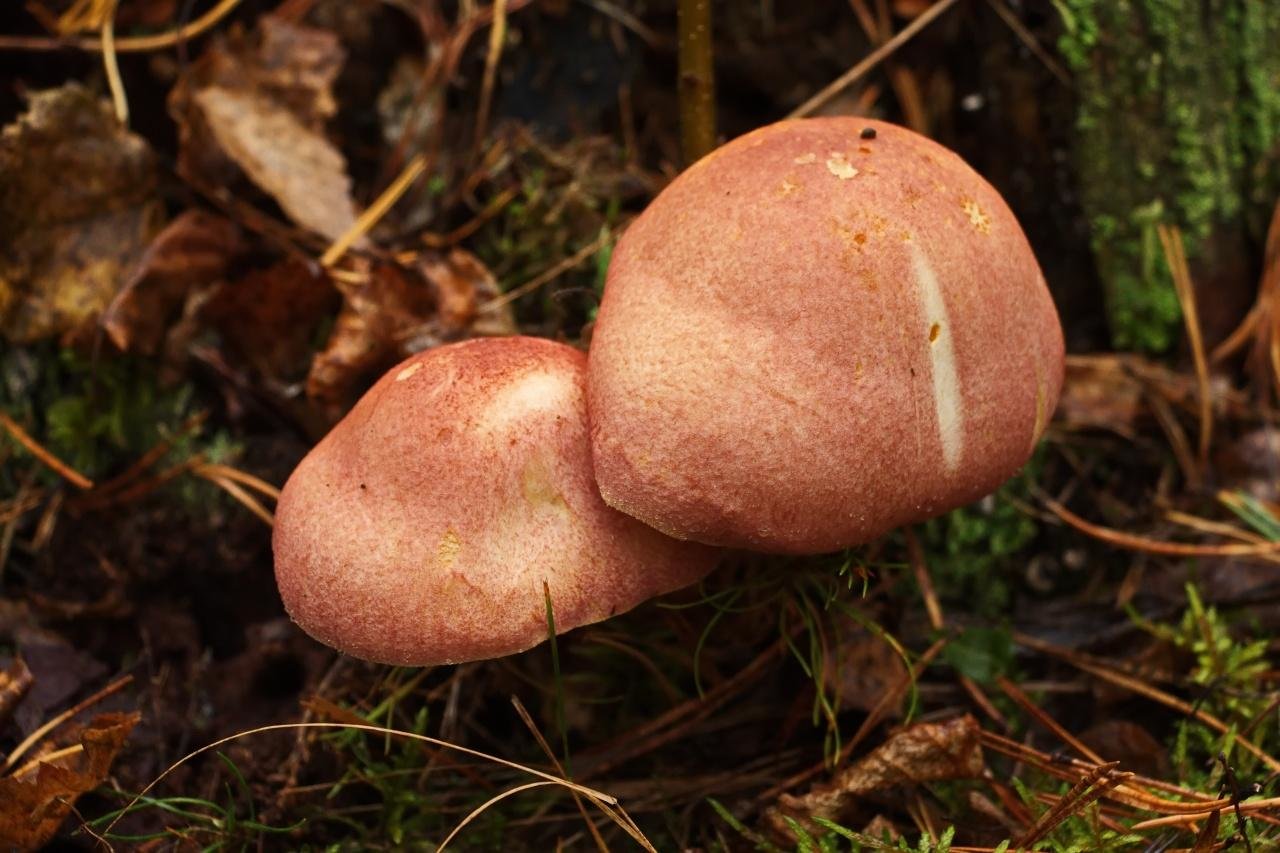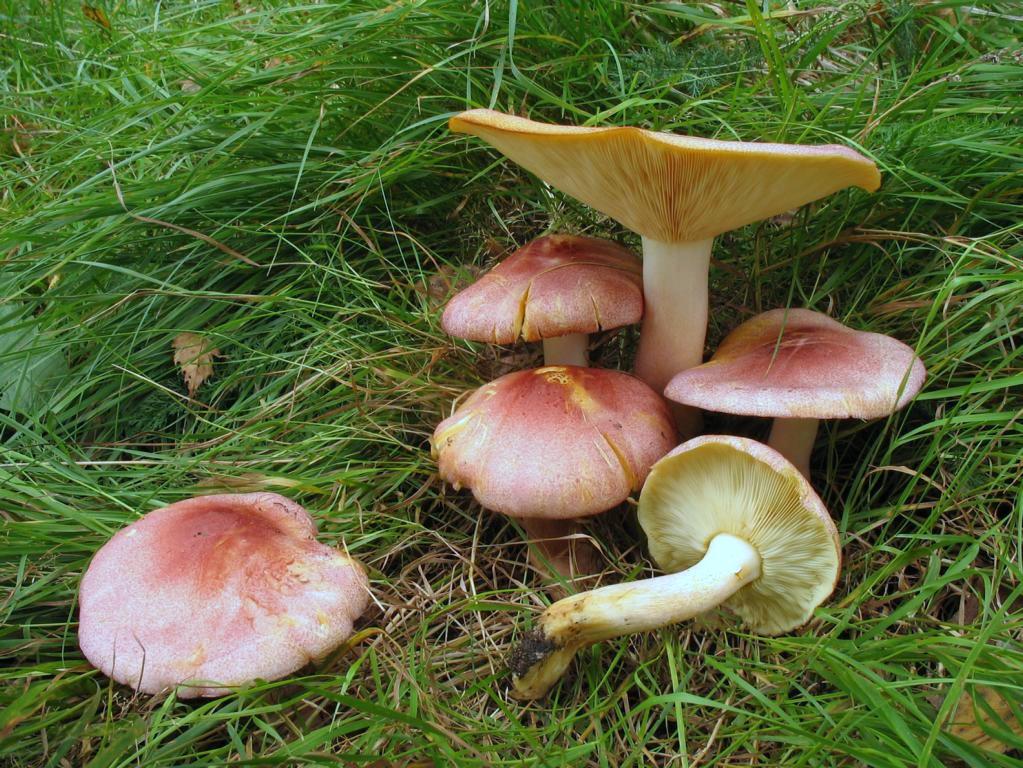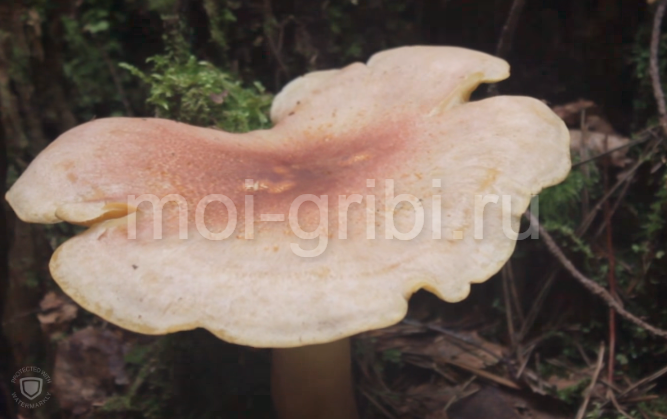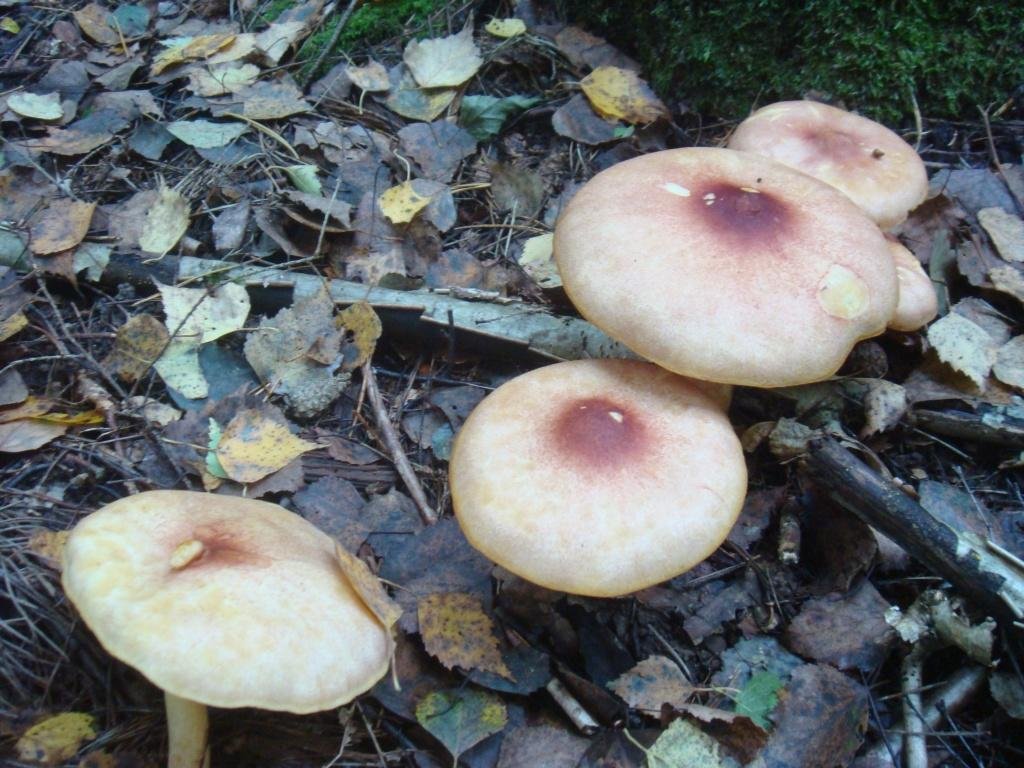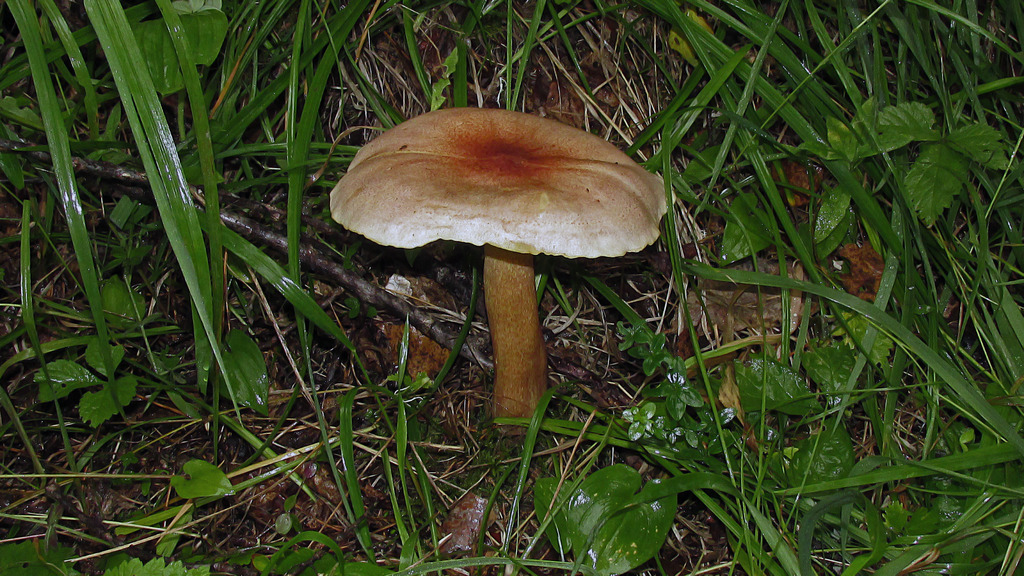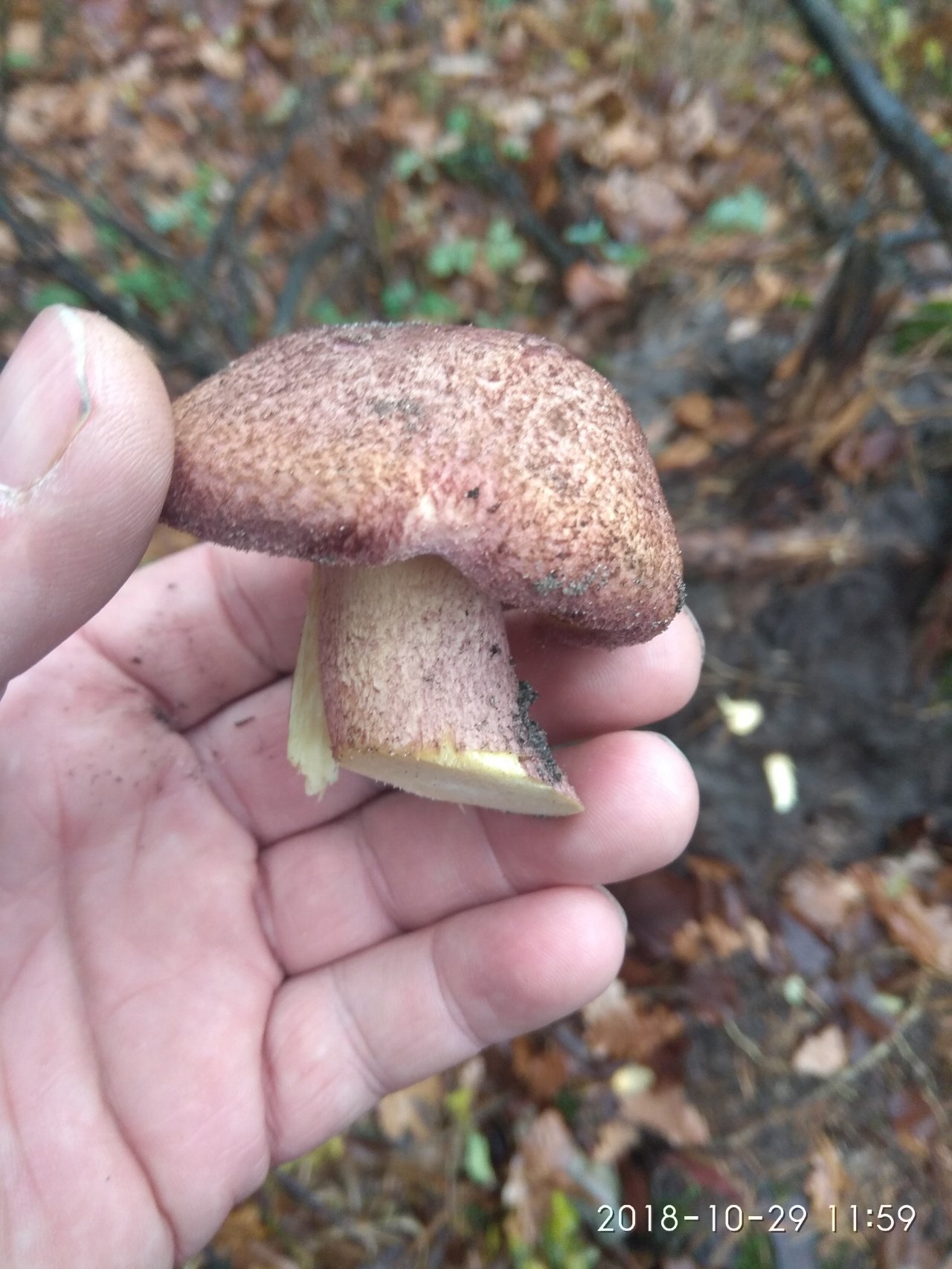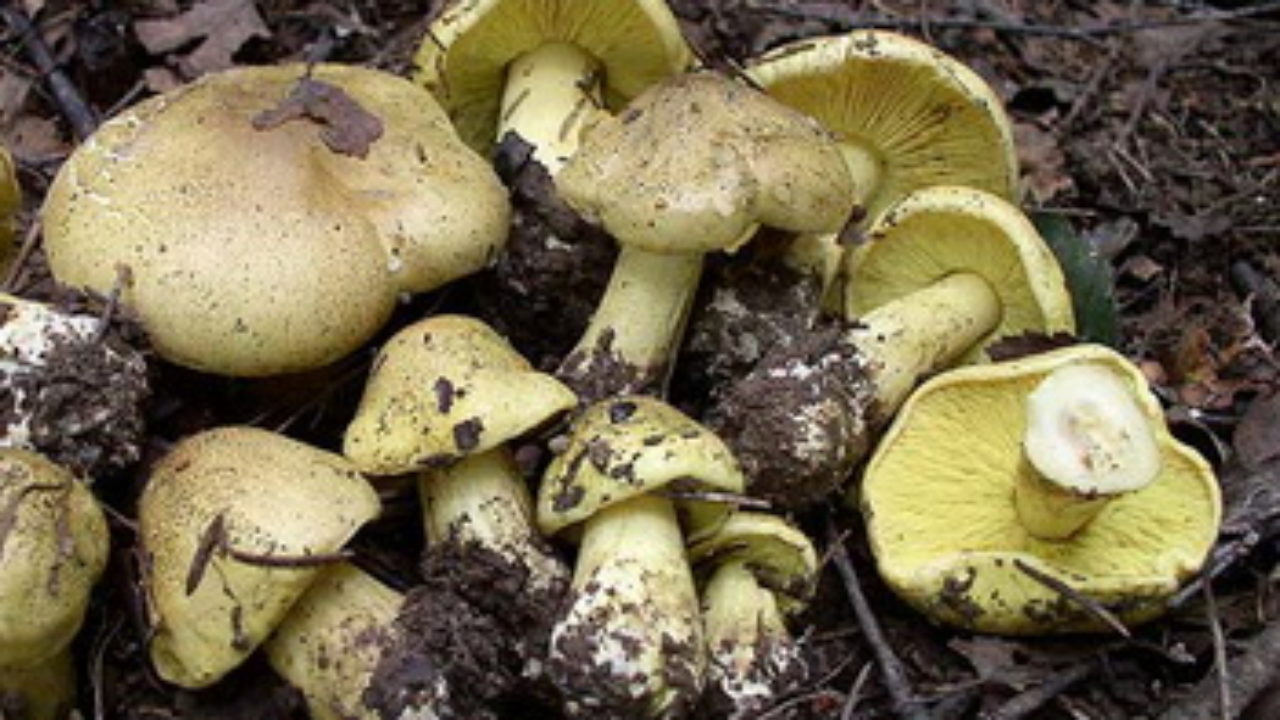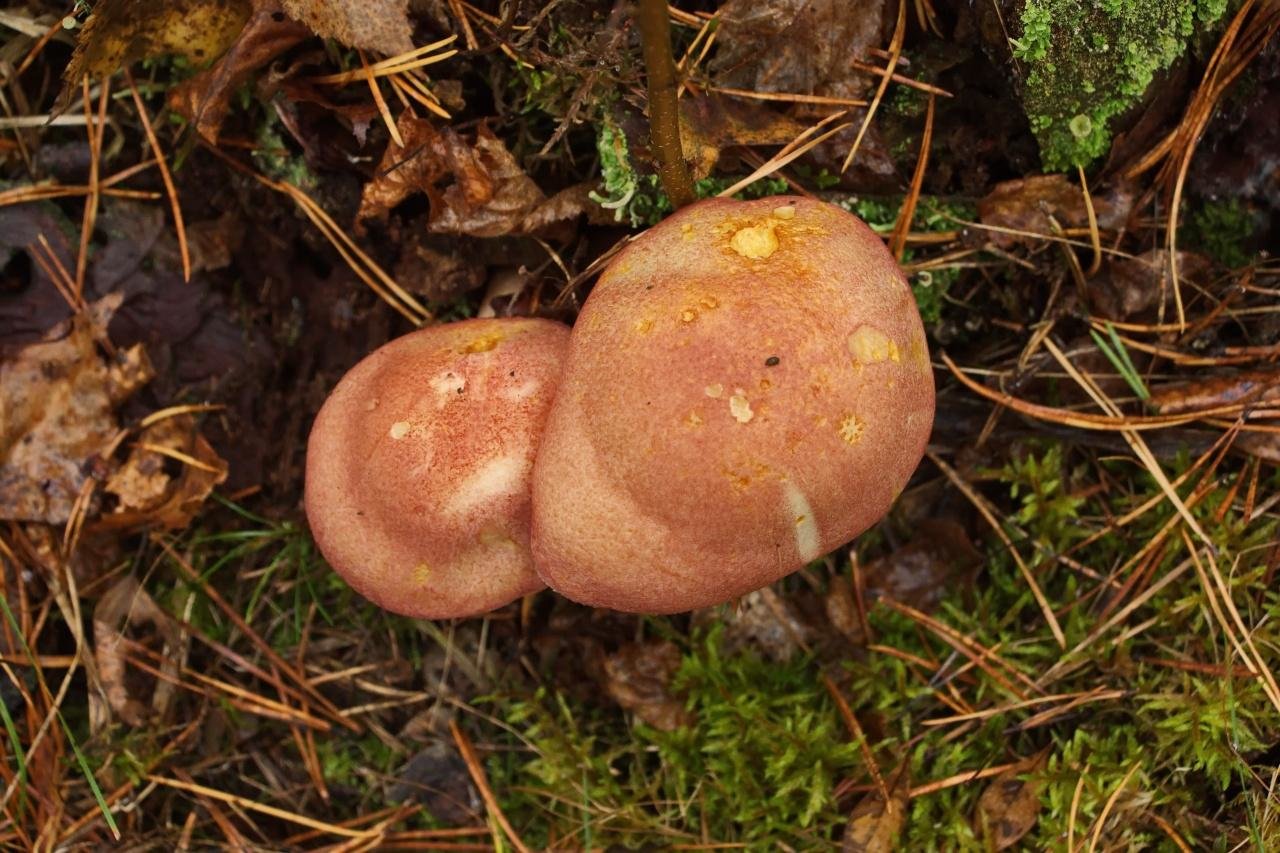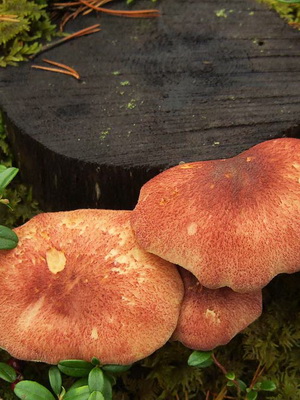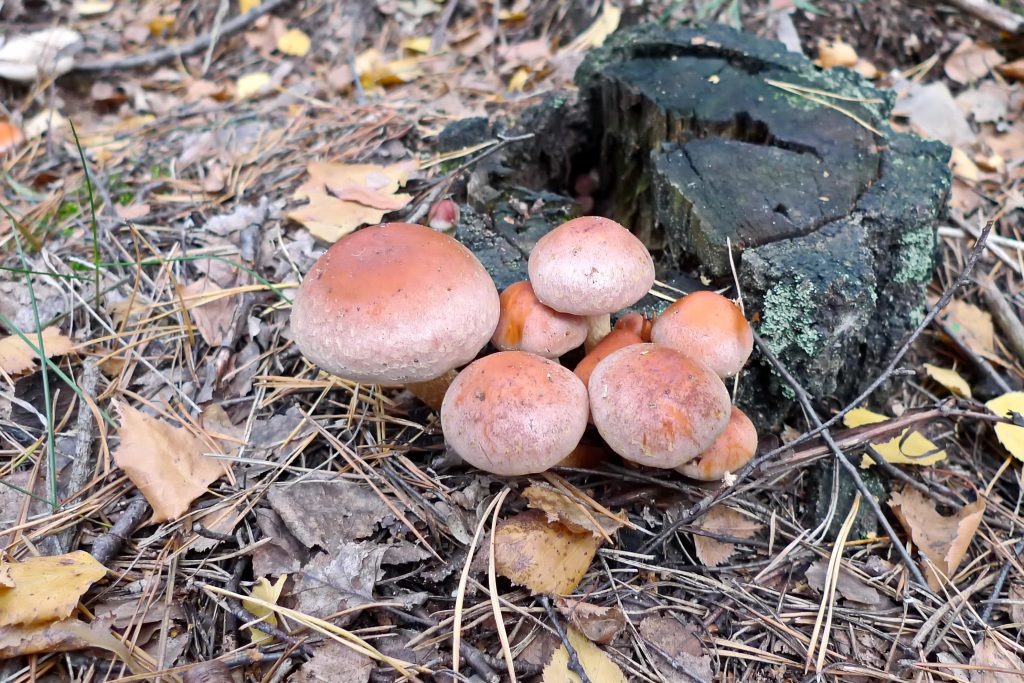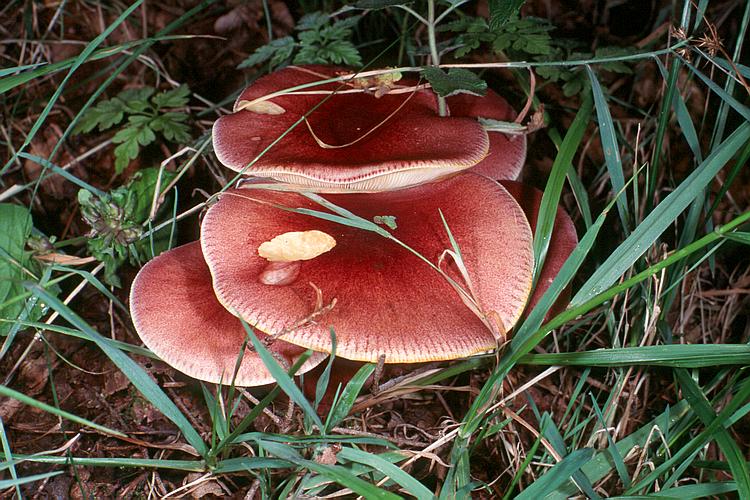Ryadovka: description of the mushroom, characteristics, photo. What does the rowing look like?
Hat
Fruiting bodies of fungi have a cap-toothed structure and are distinguished by significant variability of external characteristics. The hat of a young row, depending on the species, can be spherical, conical or bell-shaped. The diameter of the cap in different species varies from 3 to 20 cm. With age, the caps straighten and become flat-spread; in many species, a well-defined tubercle remains in the center. The edges of the cap can be even, wavy, sometimes tucked up or, conversely, bent outward.
The skin of the ryadovka cap is dry and velvety, fibrous, scaly, or completely smooth and slimy. The color of the hat depends on the species and can be pure white or it can be presented in various variations of yellow, green, red and brown. As the fungus grows, the color of the cap can undergo significant changes.
Photo by: Vyacheslav Stepanov
Hymenophore
Under the cap, ryadovka mushrooms have plates that are covered with a spore-bearing layer - hymenium. The plates of some species are thin and frequent, while in others they are sparse and fleshy, thoroughly fused with the stem. In young fungi, the hymenophore is white and even; with age, its surface turns brown, becomes covered with brown spots, and the edges become uneven or torn.
Photo Credit: James Lindsey
Leg
The average height of the leg of the row varies from 3 to 10 cm, the thickness is from 0.7 to 2 cm. The shape of the leg can be straight, cylindrical, clavate, or expanding to the top or bottom. The leg is completely naked, velvety, fibrous or covered with scales.
The main color of the leg is pinkish-brown, and under the cap there may be a sharply limited or blurred white zone. In some species, the color of the leg may be purple, and under the cap there may be a fibrous ring - the remains of a protective blanket.
Photo by: Tatiana Svetlova
Disputes and Spore Powder
The ryadovka mushroom has oblong, smooth, white or colorless spores. Spore powder is usually white, sometimes brown.
Interesting Facts
The mushroom got its unusual name for its ability to grow in rows (ryadovka) or rings.
Pine honeydew can be grown in the country. To do this, it is enough to purchase mycelium in specialized stores. Its price is about 400 rubles / 100 grams. The substrate is placed in the ground and covered with foil to maintain optimal moisture content. The crop appears in waves within 3-4 months.
The calorie content of the mushroom is low, only 20 kcal / 100 grams.
The yellow-red medicinal raspberries are used to prepare antibiotics that are effective against tubercle bacillus. Alcoholic infusions on this forest fruit are used to treat skin inflammations.
The pine mushroom undoubtedly deserves the attention of lovers of quiet hunting. Collect this beautiful mushroom by carefully unscrewing its leg from the ground, properly process and prepare aromatic, tasty dishes
But first, pay attention to the differences between this species and similar poisonous counterparts, so as not to expose yourself and your family to mortal danger.
Parameters affecting norms
Geological
When choosing a place for a cellar, it is necessary to take into account the geology of the area and climatic conditions. The temperature characteristics and moisture level in the cellar are in full accordance with the characteristics that the atmospheric air possesses.
Initially, what they pay attention to is the type of soil in which it is supposed to equip the basement
- In high-density soils, heat is given off quite easily. For example, clayey soils are considered good heat conductors. This is fraught with freezing of food in winter and heating in summer.Therefore, very high quality heat insulators are additionally used.
- Sandy loam and sandy soils are unimportant heat conductors, therefore, in the structures that are equipped in them, temperature indicators will almost always be stable. Additional work on thermal insulation is not required.
Humidity level
To maintain a good microclimate in the basement, it is necessary to maintain a balance of several factors: humidity in the cellar, temperature indicators and the inadmissibility of flooding. Violation of at least one indicator will significantly reduce the shelf life of products. At the same time, the violation of any of them entails the failure of others. For example, the formation of a dew point.
In the event of an imbalance in the factors presented, the temperature in the cellar may change during the calendar year. The reasons for this are different:
Natural ventilation cannot always cope with its task. For example, in winter, the flow of air can stop completely, as a result of which the temperature rises.
Therefore, experts advise equipping forced ventilation.
If you plan to store a lot of products or the size of the cellar is quite large, then attention should be paid to newer devices that can provide the optimal degree of moisture and temperature indicators.
An ordinary thermometer can facilitate the control of temperature parameters.
Low temperature
- The depth should be such that the temperature is the same both in winter and in summer. This can be ensured if the depth of the cellar is greater than the level of soil freezing. There are times when it is impossible to go deeply, since groundwater passes very high. This fact has a detrimental effect on the functional performance of the basement.
- If the depth is small, then the storage freezes. To avoid this negative phenomenon, they equip reliable thermal insulation.
- When the basement is located under the basement of the house, the temperature parameters may rise. This entails the need to arrange thermal insulation, which will help lower the temperature in the cellar.
If the cellar is equipped correctly, then the temperature changes in winter and summer will be small. In the case when thermal insulation of the basement is used, the temperature rises
To reduce the performance, pay special attention to the arrangement of ventilation so that its operation is not affected by the seasons.
In the event of a poor ventilation process inside the storage facility, the following can: increase in humidity, accumulate condensation, and fungus. All these negative phenomena lead to food spoilage.
Definitioner
- Basidia (Basidia)
-
Lat. Basidia. A specialized structure of sexual reproduction in fungi, inherent only in Basidiomycetes. Basidia are terminal (end) elements of hyphae of various shapes and sizes, on which spores develop exogenously (outside).
Basidia are diverse in structure and method of attachment to hyphae.
According to the position relative to the axis of the hypha, to which they are attached, three types of basidia are distinguished:
Apical basidia are formed from the terminal cell of the hypha and are located parallel to its axis.
Pleurobasidia are formed from lateral processes and are located perpendicular to the axis of the hypha, which continues to grow and can form new processes with basidia.
Subasidia are formed from a lateral process, turned perpendicular to the axis of the hypha, which, after the formation of one basidium, stops its growth.
Based on morphology:
Holobasidia - unicellular basidia, not divided by septa (see Fig. A, D.).
Phragmobasidia are divided by transverse or vertical septa, usually into four cells (see Fig. B, C).
By type of development:
Heterobasidia consists of two parts - hypobasidia and epibasidia developing from it, with or without partitions (see Fig. C, B) (see Fig. D).
Homobasidia is not divided into hypo- and epibasidia and in all cases is considered holobasidia (Fig. A).
Basidia is the place of karyogamy, meiosis and the formation of basidiospores. Homobasidia, as a rule, is not functionally divided, and meiosis follows karyogamy in it. However, basidia can be divided into probasidia - the site of karyogamy and metabasidia - the site of meiosis. Probasidium is often a dormant spore, for example in rust fungi. In such cases, probazidia grows with metabasidia, in which meiosis occurs and on which basidiospores are formed (see Fig. E).
See Karyogamy, Meiosis, Gifa.
- Pileipellis
-
Lat. Pileipellis, skin - differentiated surface layer of the cap of agaricoid basidiomycetes. The structure of the skin in most cases differs from the inner flesh of the cap and may have a different structure. The structural features of pileipellis are often used as diagnostic features in descriptions of fungi species.
According to their structure, they are divided into four main types: cutis, trichoderma, hymeniderma and epithelium.
See Agaricoid fungi, Basidiomycete, Cutis, Trichoderma, Gimeniderm, Epithelium.
- Trichoderma (Trichoderma)
-
The type of cap skin, usually consists of straight, septate elements located more or less perpendicular to the surface and laid both at the same and at different levels; the ends of the hyphae can be morphologically modified and represent dermatocystids. The surface of the cap is velvety to almost felt.
Lat. Trichoderm.
Trichoderma, in turn, is subdivided into intertwined trichoderma and irregular trichoderma.
Intertwined trichoderm (Intricate trichoderm) - trichoderm, consisting of intertwined hyphae, located not parallel to each other and forming a tomentose pubescence.
Irregular trichoderm - Trichoderma, consisting of irregularly branching hyphae.
See Dermatotsistida, Hypha, Septa.
- Cutis
-
The type of cap skin, consists of creeping non-gelatinized hyphae located parallel to the surface. The surface of the cap looks smooth.
Lat. Cutis.
See Gifa.
Yellow-red row
There are many types of rowing. Most of them are edible. Some have healing properties. The yellow-red row is a beautiful and useful species that has been used in cooking and traditional medicine for a long time.

The appearance of the mushroom
Mushroom pickers harvest the variety from July to October. Only young mushrooms are suitable for food.
The description will help to recognize the mushroom:
- the cap is initially convex, flattens with age, its diameter is 5-15 cm;
- the color of the cap is orange-yellow, pink-yellow, sometimes a purple tint is possible;
- the surface of the cap is matte, covered with brownish scales;
- the plates under the cap are wide, frequent, golden in color;
- the pulp is fleshy, sweet in young representatives, bitter in old ones, has a slightly sour smell;
- the leg is cylindrical, 4-10 cm long, 0.5-2 cm in girth, sometimes thickening from below;
- the color of the leg is yellowish, the surface is covered with red-brown scales;
- old fruiting bodies have hollow legs.
Irina Selyutina (Biologist):
The ryadovka yellow-red, unlike many other species of the genus, belongs to the group of saprophytes: like mushrooms for their development, they use dead wood, pine pine. This species is widespread in the temperate zone, bears fruit from July to the end of October and forms families of 3-4 mushrooms.
The pulp is characterized by a juicy yellow color, somewhat bitter and has a sour smell of rotten wood.
According to the external description, the reddening ryadovka looks like poisonous brick-red mushrooms. Plates of a toxic type are greenish-yellow, gradually blacken with age, the cap has a bell-shaped shape, which changes to rounded in adult specimens.
Beneficial features
Row reddening contains a lot of protein, vitamins, natural antibiotics clitocin and fomecin, which are able to fight both bacteria and malignant neoplasms. The chemical composition determines a number of beneficial properties of the fruiting body:
- anti-inflammatory;
- antioxidant;
- immunostimulating;
- anti-cancer;
- disorders of the nervous system;
- normalization of blood pressure, etc.
The use of the product has a beneficial effect on the nervous system, improves the body's resistance to various types of stress. The beneficial properties of the mushroom variety are the subject of scientific research.
Contraindications to use

Only young mushrooms are suitable for consumption.
Despite the usefulness, not everyone is allowed to eat the mushroom variety. The main contraindications:
- children under 7 years of age;
- the period of pregnancy and breastfeeding;
- diseases of the stomach and intestines in the acute phase of the course;
- renal and hepatic impairment;
- low acidity;
- pancreatitis and cholecystitis.
It is not safe to eat old red mushrooms. It is forbidden to collect fruit bodies near industrial enterprises, highways, garbage dumps: the mycelium quickly absorbs toxins.
Rows collected in violation of the rules can provoke poisoning. The main symptoms are nausea, vomiting, diarrhea, abdominal cramps, headache. The condition is treated by cleaning the stomach, taking sorbents and probiotics as prescribed by a doctor.
Row application
Red rows are underestimated by man. They received an average quality rating. They are rarely used in cooking. The medical use of fruiting bodies is being studied at the world level.
In cooking
Rows can only be eaten after preliminary cooking. The collected fruit bodies are boiled in clean water for 10-15 minutes. The nutritional value does not suffer from cooking, but the taste improves.
Irina Selyutina (Biologist):
Row yellow-red belongs to conditionally edible mushrooms and 4 categories according to taste. Due to its inherent unpleasant bitter taste and sour smell, it is recognized as an inedible species in a number of countries.
By the way. Only young rows are used for food.
After cooking, the fungi are eaten, pickled or salted for the winter. They are also added to soups. Fruit bodies are not suitable for drying. Mushrooms are a good substitute for meat in a vegetarian diet.
In medicine
The yellow-red ryadovka contains fomecin B, which has an effect on cancer cells and completely suppresses the development of cancer cells, which experts refer to as MDCK, HeLa and FL lines. Polysaccharides isolated from the fruiting body have also shown an antitumor effect in experiments on mice.
What false mushrooms can be confused with
The reddening row has several similar species. Among them there are both edible and poisonous mushrooms.
Red and yellow honey mushroom
You can distinguish honey agaric from an edible row by the following features:
- bell-shaped or rounded cap;
- sulfur-yellow, less often brownish color of the leg;
- the presence of a cobweb blanket;
- creamy gray color of the lamellar layer;
- preference for deciduous forests over coniferous plantations.

The fruits of this variety of honey fungus are poisonous.
Handle these mushrooms with extreme care.
Olive yellow row
You can determine the olive-yellow variety of the row by the following features:
- rounded bell-shaped caps with a flattened top;
- lack of shades of red in the color of the fruit;
- brownish color of the scaly layer.

The fruits of the olive yellow sandpiper are edible. When picking mushrooms, you can not be afraid to mix up the species.
Fire scale
There are not many similarities with the fiery scales in the red sandpiper. You can identify a twin by the following specific features:
- lemon-red color of fruit bodies;
- the presence of bristly scales with curled edges on the entire surface of the fruit;
- the presence of a mushroom ring in the upper part of the leg;
- a pungent smell emanating from the fruit;
- yellow flesh, turning brown on the cut.

The fiery scale is not used in cooking. Its pulp is too bitter and smells very unpleasant.
Useful properties and possible harm
- blood sugar levels are normalized;
- the heart rate is restored;
- signs of fatigue and fatigue go away;
- blood pressure is normalized;
- the body's resistance to viruses and bacteria of various origins increases.
The fruits of ryadovka have long been used in folk medicine. Even in ancient times, the antioxidant properties of mushrooms were used to cleanse the stomach and blood. Alcohol infusions removed skin inflammation. Mushroom teas have been used as a pain reliever during a migraine attack.
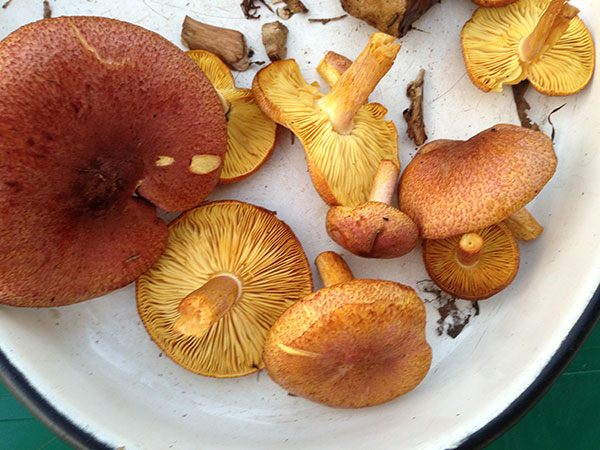
Modern traditional medicine does not disprove the medicinal properties of this type of mushroom. A strong antibiotic is obtained from ryadovka, which is used to treat patients with tuberculosis. The high concentration of protein in fruits allows the production of various dietary supplements, the action of which is aimed at maintaining the normal functioning of the nervous system and increasing human immunity.
Moderate consumption of mushroom products cannot harm humans. The only exceptions are small children, pregnant and breastfeeding women. Overeating with mushrooms is fraught with malfunctions of the digestive tract and food poisoning. The recommended daily dose of rows is no more than 150 g.
Mushroom ryadovka yellow-red (tricholomopsis rutilans): photo and description
Latin name: Tricholomopsis rutilans.
Family: Ordinary.
Synonyms: honeydew red or yellow-red, red or red ryadovka.
Hat: has a yellow skin with red or red-lilac scales. One gets the impression that it is strewn with a large number of small red dots and villi. Therefore, the hat appears orange-red or yellow-red. In the adult state of the fungus, the scales remain on the cap only in the center. At a young age, the cap has a convex shape, which eventually changes to flat. The diameter is from 3 to 10 cm and even up to 15 cm. A photo and description of a yellow-red row will show all the differences between the mushroom cap and inedible twins.

Leg: dense, yellowish with a height of up to 10-12 cm and a diameter of 0.5 to 2.5 cm. There are numerous longitudinal purple scales along the entire leg. At a young age, the leg is solid, then it becomes hollow and curved, thickens towards the base.
Flesh: bright yellow color with a pleasant woody scent. In the cap, the flesh is denser, and in the stem with a looser consistency and fibrous structure, it is bitter. A photo of a yellow-red ryadovka mushroom will show the distinctive features of the pulp of this mushroom.
Plates: yellow, sinuous, narrow and adherent.
Edible: reddening ryadovka is an edible mushroom belonging to the 4th category. Requires pre-boiling for 40 minutes to remove bitterness.
Similarities and differences: the description of the yellow-red ryadovka resembles the description of the poisonous and bitter brick-red honey fungus. The main difference between the brick-red honey fungus and the yellow-red ryadovka mushroom is the presence on the plates of a thin spider web cover with remnants of fringe, which looks like rare flakes on a leg. The plates are white, gray or greenish-yellow, in adults they are brown-green and even black-green. The cap of poisonous brick-red honey agarics has the shape of a bell, later it becomes more rounded. The leg is curved, fused at the bottom with neighboring mushrooms.
Distribution: a photo of a reddening row clearly shows that the mushroom prefers conifers and settles in their roots or near stumps. Fruiting time starts from late August to early November. Grows in temperate zones throughout Russia, Europe and North America.
Pay attention to the video of the yellow-red rowing in natural conditions in a pine forest:
Medicinal properties
This mushroom contains many useful substances, one of which is fomecin. This is a very useful biologically active component that is isolated from this mushroom.
This substance has a powerful anti-cancer effect and will suppress cancers.Therefore, the extract of this mushroom is very often used in the fight against Sarcoma, Ehrlich's disease and glioblastoma.
Also, the composition of the mushroom also contains useful polysaccharides, which in laboratory tests have shown themselves to be a good means of preventing the risk of oncology.
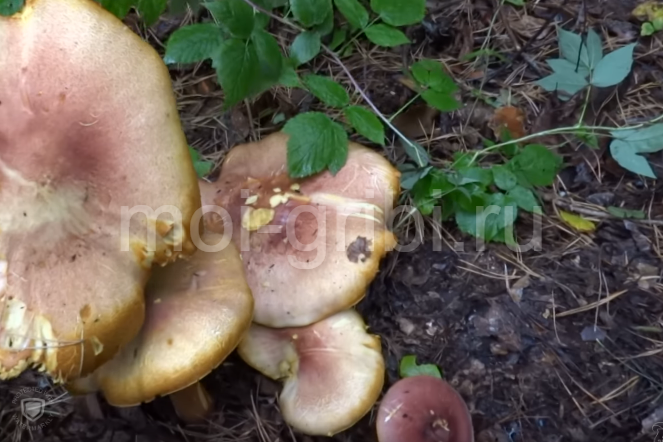
Mushroom is a powerful antioxidant, its effectiveness is proven by 90%. Free radicals are removed from the human body. Also, the ethanol content in the extract is observed, which has an anti-inflammatory effect. So, it was noted that such a mushroom is ideal for relieving people from headaches.
Even in ancient Russia, these mushrooms were used to avoid migraines. For example, it was boiled in hot water, dried, and then given to the patient for food each time. It is said that due to its analgesic effect and antioxidant nature, this mushroom quickly brought a person to their senses, and the pain and migraine were not very noticeable. And soon they completely disappeared.
If we talk about North America, then the Indians of some tribes used this mushroom raw in order to cleanse the stomach in case a person showed signs of poisoning.
The fungus quickly removed all unnecessary substances from the body, thereby allowing a person to feel better.
Recipes for cooking Ryadovki red
If you are still sure that it was the yellow-red ryadovka that got into the basket, and not its false counterpart, try to cook delicious, unusual dishes from it.
Primary processing
In order to pickle or pickle mushrooms, you will need to soak them in cool water for a long time. And for subsequent frying or use in other dishes, it will be enough to thoroughly rinse, remove forest debris and boil for 40 minutes in salted water with the addition of citric acid.
Cooking
Clean the caps and legs of the rows from the needles, rinse them well in running water. Place in a deep container, add 1 tbsp. salt (per 1 kg of mushrooms), a pinch of citric acid. Boil for 40 minutes from the moment the water boils. Then flip it in a colander to drain excess liquid. Cool and use as directed.
Pickling
In order to preserve the forest harvest for the winter, try pickling pine mushrooms.
- rows - 1 kg;
- vinegar 9% - 3 tablespoons;
- salt - 1 tablespoon;
- sugar - 1.5 tablespoons;
- water - 250 ml;
- black and allspice - 5 peas;
- cloves, bay leaves - to taste;
- garlic - 3 cloves.
- Discard the fruit bodies previously boiled in salted water in a colander, and then blanch to remove the bitterness. To do this, you need to lower them in boiling water for 5 minutes.
- Place the mushrooms in clean, dry jars.
- Prepare the marinade. Pour water into the container, add the rest of the ingredients: sugar, salt, vinegar, spices. Boil the brine for 5 minutes.
- Strain the broth and pour the boiling over the mushrooms in the jars.
- Seal with plastic lids, place containers in a cellar or other cool place.
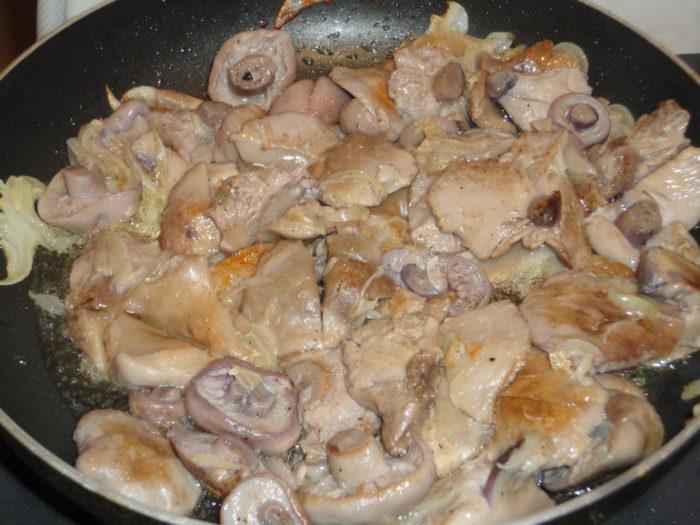 Frying
Frying
To prepare this delicious dish, you do not need expensive components, but after a while an unusual, aromatic addition to the side dish will appear on the table.
- onion - 2 heads;
- rows - 1 kg;
- sunflower oil - 100 ml;
- sour cream - 100 g;
- paprika - a pinch;
- parsley greens - 20 g;
- salt to taste;
- ground black pepper - on the tip of a knife.
- Clean the fruiting bodies, remove the tip of the stem. Wash and cut into equal pieces.
- Place the mushrooms in a container with salted water, boil for 15 minutes, constantly removing the resulting foam.
- Drain the liquid, refill the pot with cold water and cook for another half hour.
- Peel the onion, cut it into cubes or half rings and fry in vegetable oil until soft.
- Once the rows have been boiled again, fry them in another pan for half an hour.
- Combine mushroom slices with sautéed onions, spices, salt and paprika.
- Cook for another 10 minutes over medium heat.At the end, add sour cream, stew a little and serve with chopped herbs.
Salting
Try to prepare pine mushrooms this way - you will have a delicious, spicy treat for the winter!
- false rows - 3 kg;
- salt - 4 tablespoons;
- garlic - 1 head;
- bay leaf - 2 pcs.;
- black peppercorns - 8 pcs.;
- dill - 2 umbrellas.
- Clean the fruits from forest debris and needles, cut off the lower part of the leg. You can grind them, but it is better to leave them intact.
- Pour the mushrooms with cool water, add 2-3 tablespoons of salt and leave for 2-3 days, changing the water periodically so that the product does not sour.
- Cut the garlic into thin slices. Place a small layer of salt, the rest of the spices and garlic on the bottom of clean, dry jars.
- Place the product in a container in layers until the jar is full. Moreover, each layer of rows should be no more than 5–6 cm, otherwise they will not be salted.
- Tamp the contents of the cans tightly. Cover with a layer of salt, cover with gauze, and top with a lid. After 30–35 days, the workpiece can be fed to the table.
Row yellow-red - little-known edible mushroom of IV category
Row yellow-red (red, blushing), or yellow-red honey fungus (Tricholomopsis rutilans), captivates with its appearance and real mushroom smell. This beautiful mushroom with a yellow-red cap appears in forests in late summer and closer to autumn. Most often it is found near stumps or on the roots of conifers. Many mushroom pickers have a question: is the yellow-red row edible? Is it worth collecting? And how to cook? On the one hand, for the majority, this is an unknown mushroom, which, according to the main commandment of the mushroom picker, cannot be taken. It is safer to pick only well-known mushrooms. On the other hand, the yellow-red honey fungus looks quite edible. Let's try to sort out all these questions.
Description of the row of yellow-red (yellow-red honey mushroom)
Hat. The cap of the ryadovka is yellow-red, or the honeydew of yellow-red, has a yellow skin, which is covered with red, dark red or red-lilac fibrous scales. Such that it seems that the hat is slightly velvety, strewn with many tiny red strokes, dots and villi. It is because of these scales that the yellow skin looks red, red-pink, or orange-red. As the fungus grows, the scales remain mainly near the central part of the cap. The edges are visibly discolored, retaining a yellow or yellowish-vanilla skin color.
The hat of young rowers has a convex shape. As the fungus grows, it opens up, becoming almost flat. The skin is dry, slightly velvety. The plates of the cap are adherent, yellow.
The size of the cap depends on the age of the mushroom. Their diameter rarely exceeds 15 cm, more often up to 10 cm.
Leg. The dense leg of the ryadovka is yellow-red, or a honeydew of yellow-red, also yellow in color. Its height is up to 10 cm, diameter is up to 1.5 cm. Numerous purple scales located longitudinally are visible on the stem.
Pulp. The pulp of this mushroom can be not only yellow, but also yellow-cream. She has a pleasant mushroom or vague smell. It is sometimes compared to the smell of decaying wood. The raw pulp tastes bitter.
Where and when does the yellow-red ryadovka (yellow-red honey mushroom) grow?
The mushroom loves conifers. He settles in their roots, can climb on stumps (especially old ones), or can be seen nearby in the grass. Prefers pine trees. The yellow-red row grows not only in our country, but also in other countries. Its description can be found in reference books and determinants of mushrooms by foreign authors.
The growth time of the fungus is summer and autumn.
Is the ryadovka yellow-red (yellow-red honey mushroom) edible?
Row yellow-red, or yellow-red honey fungus, edible. This is a category IV mushroom that can hardly be called tasty. But together with other mushrooms it can well be cooked and eaten. The marking "inedible" in some reference books only indicates that the mushroom is of little use for mass consumption, and not that it is poisonous. In the USSR, according to GOST, the mushroom was not harvested.
The yellow-red row must first be boiled and the first water must be drained off immediately. Only then is the mushroom cooked. It is desirable not less than 40 minutes. The row can be boiled, fried and salted. One of the best ways to cook this mushroom is to marinate with other mushrooms. Slight bitterness disappears at the same time. You can harvest (salt and pickle) according to the recipes that we presented in the article "Winter honey mushroom (winter mushroom) appears at the end of autumn."
Mushroom-twin of a row of yellow-red (yellow-red honey fungus)
The ryadovka yellow-red, or yellow-red honey fungus, has such a characteristic appearance that it is difficult to confuse it with other mushrooms. However, it is worth recalling some external resemblance to the poisonous and very bitter honey fungus of the brick-red false
This is important to know so as not to accidentally put poisonous false honey in the basket instead of the edible row.
A clear difference will be the presence of a brick-red false thin cobweb blanket covering the plates, or the remnants of a fringe (similar not to a ring, but to rare flakes) in the upper part of the leg. The color of the plates is also important. It is whitish (in young false honey agarics) or grayish, grayish-cream, greenish-yellow, olive (in adults). Occurs brownish-green or black-green (in old ones).
The shape of the cap in young false honey agarics is bell-shaped, later round.
The leg is elongated, curved, fused from below with adjacent mushrooms. Its color is sulphurous yellow or with a brown tint.
Brick-red false honey fungus appears from August, mainly bears fruit in autumn (massively in September). This bright mushroom cannot be collected. It is sometimes confused with autumn honeydew, which leads to severe poisoning.
Benefit and harm
The yellow-red ryadovka contains vitamins of group B, C, A, K, minerals, amino acids and natural antibiotics. Dishes based on this mushroom are recommended for diet nutrition, as well as for people actively involved in sports.
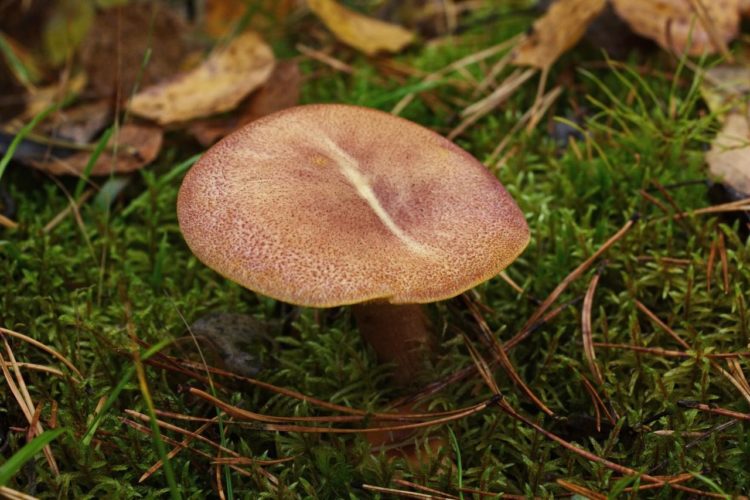
The use of ryadovka brings tremendous benefits to the body:
- takes part to normalize blood sugar and blood pressure;
- helps to restore heart rate;
- relieves signs of fatigue and overwork;
- increases the body's resistance to viruses;
- the growth of cancer cells is significantly slowed down.
Important! The yellow-red ryadovka should be taken with caution in case of kidney and gastrointestinal tract diseases - be sure to consult your doctor first. Also, this mushroom is not recommended for children and women during pregnancy and during breastfeeding.
This type of rowing brings tangible harm to the body when overeating.
The daily allowance of the product should not exceed 150 grams. If this dosage is violated, stomach pains, diarrhea, nausea and weakness are observed. In such cases, it is necessary to immediately wash out the stomach - drink plenty of warm water and induce vomiting. Then the patient should be provided with bed rest and given a tablet of activated carbon.
This type of ryadovka brings tangible harm to the body when overeating. The daily allowance of the product should not exceed 150 grams. If this dosage is violated, stomach pains, diarrhea, nausea and weakness are observed. In such cases, it is necessary to immediately wash out the stomach - drink plenty of warm water and induce vomiting. Then the patient should be provided with bed rest and given a tablet of activated carbon.

